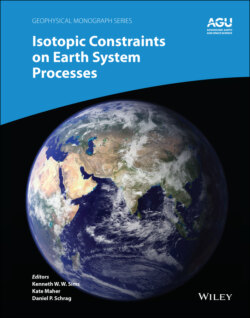Читать книгу Isotopic Constraints on Earth System Processes - Группа авторов - Страница 22
1.2. DIFFUSION IN MULTI‐COMPONENT CONDENSED SYSTEMS: THEORY AND DEFINITIONS 1.2.1. Fick’s Laws and the Diffusion Matrix
ОглавлениеFick’s first law of diffusion
(1.1)
is often used to characterize the particle or molar flux Ji (i.e., particles or moles of i per cm2 per second) in terms of the gradient in particle or molar density ρ i (particles or moles of i per cm3) and a proportionality constant called the diffusion coefficient Di with units of length square per unit of time. Fick proposed this simple flux law in 1855 for physical particles by analogy to Fourier’s law of heat conduction. With this representation of the flux, the one‐dimensional conservation equation of ρ i, often referred to as Fick’s second law, is
(1.2)
However, Fick’s law is known to be inadequate for representing the flux due to chemical diffusion in a multi‐component, non‐ideal system such as a silicate liquid. It cannot explain, for example, uphill diffusion, such as that shown later for Al2O3 in Fig. 1.3, or that the rate of diffusion of a component in a multi‐component system depends on the direction of diffusion in composition space.
Onsager (1945) showed that a way to deal with transport in a multi‐component system is to express the diffusive flux of a component as a linear combination of the concentration gradients of all the independent components in the system. The one‐dimensional diffusive flux of component i in an n‐component liquid is then given by
(1.3)
where Dij are elements of a (n‐1) by (n‐1) diffusion matrix with the nth component taken as the dependent component. For example, equation 1.3 for the ternary system CaO‐Al2O3‐SiO2 can be written in matrix form as
(1.4)
when SiO2 is taken as the dependent component. The flux of the SiO2 can be calculated using or depending on the reference frame, by requiring that the sum of all the volume fluxes ν i Ji ( ν i is the molar volume of species i) must add up to zero (see de Groot & Mazur, 1962).
Another issue that is especially relevant in natural silicate liquids is that the driving force for chemical diffusion is chemical potential gradients ∇ μ i ( μ i now denotes chemical potential, not reduced mass). The more general version of equation 1.1 is
(1.5)
where the Li is called the phenomenological coefficient for diffusion and is now identified as the diffusion coefficient for a non‐ideal binary system. The extension of this to a multi‐component system governed by a phenomenological diffusion matrix Li,j was studied experimentally by Liang et al. (1966a; 1966b; 1967) with the non‐ideal molten CaO‐Al2O3‐SiO2 system.
